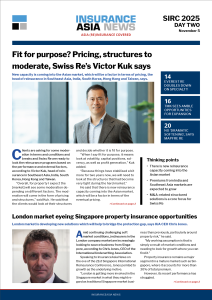SIRC: Reinsurers’ growing enthusiasm for tailored solutions in APAC
November 5 2025 by Mithun Varkey
After several years of hard market conditions, the APAC reinsurance market has turned a corner. We head into the 2026 renewal with ample capacity and good appetite from reinsurers. But this offers cedents more than just an opportunity for cost relief – it also widens the scope for innovative and tailored reinsurance programs.
For many years now, insurers in the APAC region have been taking advantage of sophisticated reinsurance structures that can smooth out volatility over several years, or help support solvency.
But as the cycle moves on, it is a good moment for insurers to take stock of their strategy and consider other solutions that may add value.
In this article, Gallagher Re’s head of strategic solutions for APAC, Roshan Perera, and global practice leader for customised solutions, James Mounty, give an overview of the volatility and capital management challenges currently faced by clients in the region – and offer some ideas for how to meet them.
1. What are the most pressing balance-sheet challenges faced by insurers in the APAC region, at this point in the market cycle?
James Mounty: One of the key challenges is managing the net (or retained) volatility associated with natural catastrophes – in both property and motor, which are significant business lines across the region.
For those exposures, the level of retention on excess of loss (XoL) reinsurance programs is probably higher than clients would like. So they are looking for reasonably priced mechanisms to buy out the volatility, because it supports their earnings. Organisations that manage volatility well tend to be recognized and rewarded by owners and/or the investor community.
Roshan Perera: Insurers’ minimum capital requirements are increasing in some markets, for example Indonesia. This can drive consolidation and M&A activity, as has already happened in the Philippines. Structured reinsurance transactions, such as loss portfolio transfers (LPTs), can help support such deals – for example, in situations where a buyer is interested in acquiring an insurer, but wants to divest a particular line of business.
2. Several markets in Asia-Pacific are either introducing or updating risk-based capital (RBC) regimes for monitoring insurers’ solvency. Can structured solutions help here?
RP: In our APAC market report, we talk about the five forces shaping insurance business in the region – and one of them is the harmonisation of regulation. There are only two markets that are still on a pre-RBC framework – Vietnam and India – and they are both looking to introduce an RBC framework over the next three years.
While insurers in both markets already make good use of structured solutions, we are anticipating that there will be growing interest in capital-supporting reinsurance structures, and potentially retrospective deals to remove unwanted liabilities.
3. What are the structured solutions that APAC clients typically use, and how do they work?
JM: The implementation of a structured solution is often about customising a traditional reinsurance product so that it achieves a targeted outcome in the most cost-effective manner. Our first step will be to understand what the client wants to achieve.
When the outcome required is capital relief, often the solution is a structured quota share.
These are a really great way for insurers to finance expansion without overextending their capital base – or ceding too much margin to reinsurers.
 Under a surplus relief quota share or SRQS arrangement, the ceding commission rate can slide up or down depending upon the loss ratio performance. This rewards the ceding company if results are better than the provisional loss ratio plan, but it will also protect the reinsurer if the outcome is worse than plan.
Under a surplus relief quota share or SRQS arrangement, the ceding commission rate can slide up or down depending upon the loss ratio performance. This rewards the ceding company if results are better than the provisional loss ratio plan, but it will also protect the reinsurer if the outcome is worse than plan.
Where clients are looking to control net volatility, we often use the multi-year XoL structure. These have been very popular across the APAC region for many years, as a way of managing the frequency risk at the bottom end of programs.
If the insurer avoids a negative outcome in year one, it can bank the profits via an early commutation and renegotiate the deal. If the loss experience is less favorable, then they have the security of knowing that cost and capacity are locked in for a further two years.
There are also good opportunities to explore aggregate XoL covers in the current market, and structured aggregate XoL is no exception. Since structured solutions can often attach lower, you might create a mix-and-match approach – a structured solution attaching closer to the expected loss, with conventional aggregate protections attaching higher up the probability distribution.
Ultimately, we are looking to support our clients to achieve their financial objectives in the most efficient manner possible. Regardless of where we are in the market cycle, we think there are always reasons to consider some degree of customisation.
4. Can you give some examples of how APAC clients are making use of these kinds of solutions?
 RP: Take increasing capital requirements as an example. Recently, we helped one client in Indonesia that was quite close to the statutory minimum for the dynamic solvency requirement. We put in an arrangement called a financial-year quota share (FYQS) to help address that. These types of structures combine prospective and retrospective cover, giving immediate and significant capital relief for the duration of the financial year.
RP: Take increasing capital requirements as an example. Recently, we helped one client in Indonesia that was quite close to the statutory minimum for the dynamic solvency requirement. We put in an arrangement called a financial-year quota share (FYQS) to help address that. These types of structures combine prospective and retrospective cover, giving immediate and significant capital relief for the duration of the financial year.
Another recent deal in Malaysia was for a client who had grown their motor insurance business quite rapidly, to the point where they could not meet the capital requirements to fund that growth. So they did an LPT deal to help free up those funds so they could continue to grow.
5. What are reinsurers’ current appetite for structured solutions, and how does that affect their cost?
JM: Over the past year, we have seen a significant increase in the number of reinsurers telling us they are interested in writing structured business – and we do think this will lead to some modest pressure on margins. Coming into this renewal, there are at least five large new reinsurers for us to talk to, and perhaps as many as 10.
RP: I have also had several conversations with new markets who are establishing themselves in APAC and have told us they are keen to do structured deals.
We are aware of several global reinsurers active in the region that are making hires and have plans to enter this market, as well as regional Asian reinsurers that have been ready to engage on structured programs.
-
Beazley | What does cyber protection look like from day 1 to day 600 and beyond?
Cybersecurity is no longer just an IT concern, but a governance issue that belongs on the boardroom agenda.
-
Sedgwick | Preparing for the next storm
Insurance industry needs to recalibrate, invest in innovation and strengthen systems, talent and data practices.
-
Peak Re | From climate modelling to market opportunity: Forging a new clarity on Southeast Asia’s climate risk
Southeast Asia's protection gap: a crisis of clarity, not just capital
-
BHSI WICare+ | Accelerating Payments, Empowering Recovery
Launched in cooperation with Steadfast’s Singapore network, WICare+ fills the gaps found in traditional coverage and keeps businesses and their workforce secure by covering up to SG$350,000 in medical expenses per claim.

